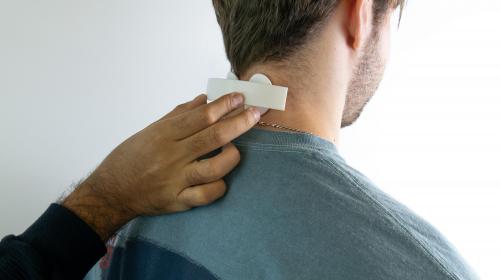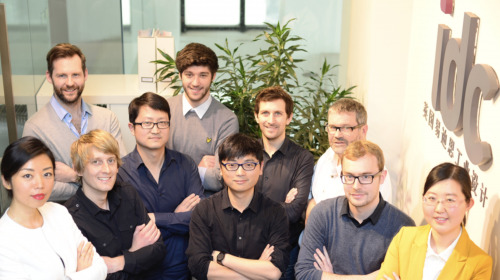Four Decades in Model Making: A Conversation with IDC's Mark Yoxall
Can you share your journey into modelmaking?
So, here we are 42 years later. I started off as a pattern maker, from school, I embarked on a five-year apprenticeship which sent me to college, once a week, in Hackney in the East End of London, where I would do coursework. Then, the other four days, I would work in the workshop learning practical skills. So that was five years and then after that I continued being a pattern maker for another five years. Then I saw pattern making starting to die out and I thought ‘I better find something else to do’, you know, there's not going to be a lot of pattern-making work around here, so I need to diversify. That's when I became a model maker. After 10 years of work. I joined an aeronautical company, and I was employed to make accurate models and moulds for expanded foam parts.
What sort of parts were you making these moulds for?
Casings for handheld things, you know, TV screens, recording studio mixers in a big deck, you know, with all the sliders and little buttons all over it, needles going backwards and forwards, all that built into this great big unit. It was good though, making something that big. Then, from making an accurate model out of acrylic, we would make a mould from that. Then from a mould, we produce the items which they would then paint up and make them look really nice. I spent quite a few years making those parts, about 14 years doing that. I really enjoyed it over the years, I got to make some really nice models, not just like casings and stuff, but I got to make helicopters and stuff like that. We made like quarter scale tornadoes, you know, so they were huge. They took up most of our workshop at the time. We would make them all liveried up with weapons and stuff and camo sort of paint work done on it. They were really nice and a lot of stainless steel work put inside to support it since going outside an airbase in Saudi Arabia.

How does your role today differ from what you were doing in your early years?
When I first started here, the guys upstairs were all on the drawing boards, with set squares and creating drawings. Then my job was to make the prove out for them and prove that their drawing was correct before we sent it to a tool maker to make it. It was like a bit of insurance because making expensive tools costs a lot of money and you want to get it right first time, you know, and if they want to change things, the time to change is when you're in the prototyping stage. So that's how I started here and that's how the business was at that time. But now things have grown, and we do things differently. You know, and I don't realise, I've grown with it, I've been a part of the change but not realising I'm a part of the change. It is just new ways of doing things and you adapt to the new way of doing things.

What has been the biggest change you have seen in your career as a modelmaker?
I think one of the biggest changes for me has been making injection moulds, I've never made injection moulds before. When I worked in this aeronautical company I used to work next to two tool makers. So, I used to look at what they were doing all the time, but I was never a tool maker. But when I joined IDC, over the years, we've started making our own injection moulds. And it's great. I love it. It's quite interesting, but mind straining, you know, because I'm trying to learn a totally new process. But we've managed to do it one way or another. I feel inspired by Steven Knowles, who believes in me to make these things happen. That makes a big difference having someone who backs you. When you don't always think you can do it, but they go ‘yeah, you can do it’. And you do, do it. It does happen. That's nice having that support.
Do any projects stand out as being your favourites?
I think one of our favourite projects, for all the guys who were here, was when we made a racing car, a Formula One racing car for Red Bull. I think this is probably one of the things we all remember still. It's one of those projects that stick in the back of your mind. One, because it's such a big company and celebrities that you're dealing with, but also, we’re all car nuts, all blokes are car nuts, so it was a great thing to do. We built this car for Sony and Red Bull and it was 4.7 metres long. We had to cut a bit of our workshop out just to get it out of the building. It was tight on timescales. We had five weeks to build this model from start to finish. We couldn't afford to miss the deadline, there was a clause, ‘you cannot miss the deadline’. But we managed to do it. We worked from 7 in the morning to 11 at night, for five weeks.


Any other projects you enjoyed that involved working on a smaller scale or working in more intricate ways?
Yeah. So, I really enjoyed working with Nick Chubb on a project called Ncam. It was great. I'll show you some of the items that we machined. This is the thing that we made, and it goes together like this, and you can see the fit, you know, it's, it's perfect. We made a load of them. When I say a load, I mean about 10. But for me, it was great, because I had all the machining strategies to think about. This surface here had to be perfect and look lovely. It just gently gradients into different shapes and forms. So, I had to make sure I machined that really well. As you can see, that's straight off the machine. For me, the strategy was to think ‘what is the best way to machine this?’ and ‘how am I going to do it?’ So, I machined round the outside first, then I created a jig to hold this, because there's not a straight side on it to hold in the vice. I then turned it up on its side there and machined these little slots all the way down here and this pocket. But you have to be dead right. They're beautiful. They then get anodized black. They do look smashing when they're done. But it's also nice to see them in the raw form before they get anodized.

What skills do you think someone looking to go into modelmaking today needs?
I think somebody joining a modelmaking company today, as a youngster, will have to have their eyes open because they're going to see different processes, lots of different processes. And being open to learning them really. I mean, it's going to be hard is, but I would say stick at it and it will come good and it will become clear in the end. I remember when I started patternmaking I found it very difficult thinking in reverse. But you overcome that in time. The more you do it, the easier it comes. So, youngsters don't give up. Follow your heart, follow your dream. If you're passionate about it, and you love doing it. See I love helping people, this is what I like doing. That is what gives me the buzz. I like thinking that we make a difference to people's lives, you know, I might save someone's life. By making something with one of the engineers, we could save someone's life. That is a wonderful thing to be able to do. I'd say to youngsters joining today, it's going to be a long journey, but you'll have a job for life.
Looking back, do you think you'd have done anything differently?
Looking back? No, not really. I mean, when I was about to leave school was going to be a boat builder. I had a job as a boat builder at a place called Peter Free Bodies in Hurley. Making real wooden boats, they were renowned in the country for being a specialist boat building company. So, when you see these boats on the Thames with gloss wood and they look lovely. That's what I wanted to do. Two weeks before I was leaving school I went down to see my boss to say you know, looking forward to coming in in a couple of weeks time. He sat me down he said I'm really sorry I can't take you on. I've really become short of work and there isn't going to be an apprenticeship for you. I felt like my world dropped out at the time.From there I went to the job centre and the job centres sent me for a pattern making job and I really haven't looked back since. I must thank my mum for making me take my patterns that I'd made for my O-level metalwork at school. I made a wood turning lathe and so I had patterns for making the head and the tailstock and the rest. I made these patterns and I cast them at school in aluminium. We had a furnace when I was at school. I cast them and then machined them all at school and that's how I got my O-level in metal work. I took these with me to my job interview and he was so impressed on the day. Seeing that I could make a pattern and machine something at 15/16 years of age he rang and said that the jobs yours that afternoon. I probably went for the interview at say 12 o'clock or 1 o'clock and by 3 o'clock I got the phone call to say the job is yours if you would like it. I wasn’t sure at the time because I thought I was going for this boat building job, and I was just going for the experience really of being a pattern maker. My dad rang a friend who was a tool maker and he said if he becomes a pattern maker he’ll have a job for life. He was wrong. I have had a job for life, but different jobs.

That sounds great, you wouldn't see any of that stuff at school these days?
Yeah. I've got a son who is 17 nearly and you know I find it terrible, DT at school, they've lost it all. I mean, we had a forge at school and I made scrollwork, you know, I got metal and I bent it and I hammered it into shape and made a bookcase out of wrought iron metal. We used to do things out of copper and polish them. Then powder, coat them. So, in my metalworking class, we had a furnace. We could melt metal. We had plastic coating. We had a mill. We had a lathe. We had a shaping machine. All those things. That's why I was at school. I used to go after school and go to the metalwork class and do stuff because I just used to love making things you know. I do love making things. Yeah, just the more accurate it is, the happier I am. If you know, I mean, but it pushes me that's the thing. It pushes me to the limit really sometimes.
Sign up for our top resources and articles on product development.


